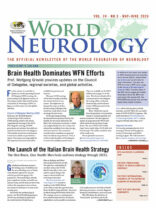More than 250 participants and speakers bring updates on Parkinson’s disease, migraines, and more.
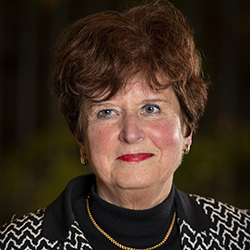
Marianne de Visser
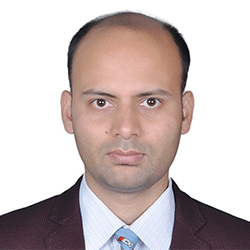
Rajeev Ojha
Rajeev Ojha and Marianne de Visser
I was fortunate to be invited to the First International Congress of Nepalese Academy of Neurology May 18-19 in Kathmandu, Nepal. Sessions on major neurological disorders, such as stroke, movement disorders, demyelinating disorders, epilepsy, headache, and cognitive neurology filled two conference days. There were also sessions on neuromuscular disorders and general neurology. Plus, there were posters and oral communications presented by early-career neurologists and residents. Dr. Rajeev Ojha, co-author of this report, was instrumental as one of the organizers of the congress, and he invited me to participate in the congress.
When I was on stage for my talk, I conveyed a message from WFN President, Prof. Wolfgang Grisold, in which he congratulated the president of the Nepalese Academy of Neurology on this unique event. It was a splendidly organized congress in a beautiful hotel in the center of Kathmandu, thanks to the assistance of the upcoming neurological generation and volunteers from the medical school. There were more than 250 participants and many speakers from abroad, including India, Malaysia, the Netherlands, Spain, and the United States.
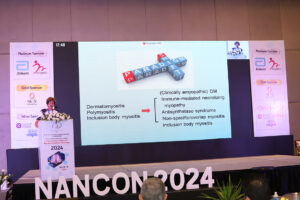
Prof. Marianne de Visser giving a lecture during the neuromuscular session of congress on the second day.
During breaks between the sessions, there was plenty of time for networking. We were able to discuss how training in neurology and neurological care was organized in Nepal. The standard of care in Nepal is impressive considering that according to the World Bank it is a low- and middle-income country. MRI and endovascular interventions are readily available. However, the cost of thrombolysis and mechanical thrombectomy is high, and the insurance service is not available to most of the general public.
Prof. Shen-Yang Lim, co-lead of monogenic portal development and underrepresented populations for the East Asia branch of the Global Parkinson´s Genetics Program (GP2), congratulated Nepal on being connected to the GP2, which is a collaborative research program to understand the genetic architecture of Parkinson´s Disease. Dr. Avinash Chandra from Nepal highlighted how oral abortive treatments for migraine, such as rizatriptan and sumatriptan, have been available for a few years and recently zolmitriptan has been made available in nasal spray. On the other hand, local speaker Dr. Niraj Gautam spoke about the unavailability of monoclonal antibodies used in the treatment of multiple sclerosis in Nepal. Prof. Lekha Pandit, from India, and Prof. Xavier Montalban, from Spain, presented an excellent diagnosis update and a discussion about the management of multiple sclerosis, respectively.
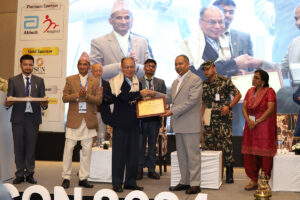
Right Honorable Vice President of Nepal, Mr. Ram Sahaya Prasad Yadav, congratulating first Nepalese neurologist Prof. Dinesh Bikram Shah during the inauguration ceremony of First Nepalese International Congress 2024.
The organizing committee included a neuromuscular session in the program. I selected myositis as a topic. Another speaker in that session was Prof. Nalini Atchayaram, from India, who gave a presentation on Hirayama disease, a disorder that should not be missed because it is treatable by surgery and may mimic ALS. She cited studies composed of hundreds of patients with this disease who, if diagnosed early, usually had excellent outcomes.
The other speakers gave excellent presentations on the diagnostic approach of muscular dystrophy (Dr. Saraswati Nashi, also from India) and on ocular myasthenia gravis (Prof. Rabindra Shrestha, from Nepal). Part of the congress was dedicated to an amazing cultural event with dancing and singing by local dancers in traditional costumes from different regions across Nepal.
All in all, this was an extremely inspiring and memorable congress that also put early career neurologists in the spotlight. During the breaks, many neurologists were willing to share the history of neurology becoming a separate discipline in Nepal and how they managed to establish three training centers across Nepal. There is an urgent need for training more neurologists (currently four residents per annum), since Nepal currently has 35 neurologists for a population of 31 million inhabitants.
I am indebted to the organizers of the congress, in particular to NAN President Prof. Kumar Oli and Secretary General Prof. Rabindra Shrestha. To my esteemed colleague and co-author, Rajeev Ojha, and to everyone who made my first visit to Nepal an incredible experience, I would like to express my sincere gratitude. •
Marianne de Visser, MD, PhD, FEAN, is a neurologist at Amsterdam University Medical Center in the Netherlands, and emeritus professor of neuromuscular diseases. Rajeev Ojha, MD, DM, FEBN, is a lecturer in the department of neurology at Tribhuvan University Institute of Medicine in Kathmandu, Nepal.
